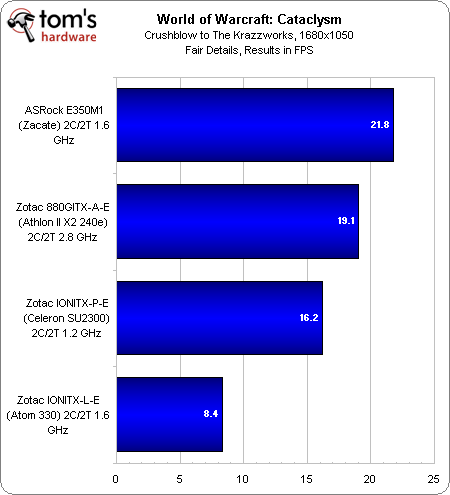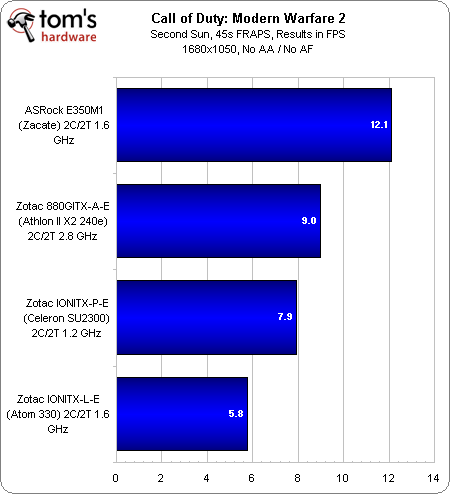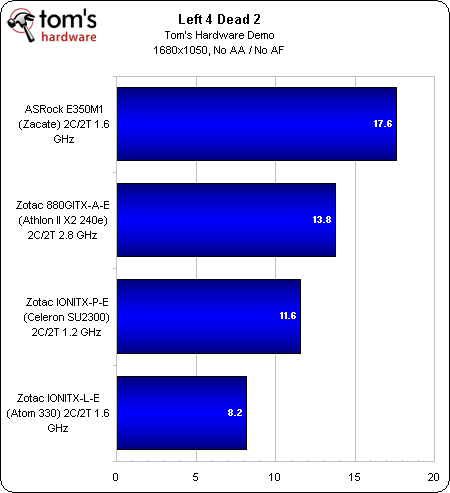ASRock's E350M1: AMD's Brazos Platform Hits The Desktop First
We had the opportunity to preview the Zacate APU late last year at AMD’s headquarters in Austin, Texas. Now we have the first retail motherboard based on the Brazos platform in ASRock’s E350M1. Today we’re asking: what can the Fusion initiative really do?
Benchmark Results: Integrated Gaming
Despite its significantly slower processor, AMD’s Brazos platform cruises right past the Athlon II X2 240e-equipped 880G platform’s Radeon HD 4250 integrated graphics engine. The 80 stream processors built into the E-350 help offset the two power-conscious Bobcat cores running at 1.6 GHz.
And while the Celeron/Ion combination proves to be more potent than Brazos in many desktop applications, it’s simply outclassed by both of AMD’s graphics solutions.
If you were wondering how CPU-limited World of Warcraft can be, compare the Celeron and Atom numbers. Both platforms enjoy the benefit of Nvidia’s Ion chipset. However, because Atom lags so far behind, it’s only able to achieve half of the frame rate—which is nowhere near playable at 1680x1050.
Update (1/16/2011): After a number of requests for gaming numbers with a Radeon HD 5000-series card dropped into the E350M1's four-lane PCI Express slot, I re-ran all three of these titles using a 5750.
In World of Warcraft: Cataclysm, AMD's Radeon HD 5750 achieved 45.37 FPS, more than doubling the integrated Radeon HD 6310's performance. Given the ratio of 720:80 ALUs, the discrete card seems fairly clearly bottlenecked by its host platform.
Call of Duty: MW2 gives us an even more constrained performance picture, clocking in with 18.88 FPS (compared to 12.1 from the integrated engine). The upgrade is certainly not worthwhile there.
In Left 4 Dead 2, the discrete card achieved 39.55 FPS, more than doubling the previously-recorded result.
Get Tom's Hardware's best news and in-depth reviews, straight to your inbox.
If you were serious about playing Call of Duty, you could probably dial in more viable quality settings than what we’ve tested here to help push frame rates higher. The important takeaway is that the performance story doesn’t change. AMD’s E-350 APU is faster than an Athlon II X2 240e/880G combination, a Celeron SU2300, and an Atom 330. Once again, we also see the hit you incur shifting from Celeron to Atom using the same graphics engine.
Another game, another victory for AMD’s on-die graphics. Just for kicks, I dialed everything down to 1280x768, using Medium quality settings, and managed a fairly modest 32 FPS. That’s not great in the living room, but it could make Left 2 Dead 2 playable on a netbook.
If you’re concerned about the fact that we only ran the 880G-based platform with a single DDR3 memory module (rather than utilizing its dual-channel capability), don’t be. The graphics core isn’t overly bandwidth-starved. Dropping a second 4 GB DDR3-1333 module into the board only bumped frame rates up to 14.21 (up from 13.8).
Current page: Benchmark Results: Integrated Gaming
Prev Page Test Setups And Software Next Page Benchmark Results: PCMark Vantage-
iam2thecrowe now they need some devs to take advantage of that apu to see its full potential as a processor.Reply -
Reynod This is an awesome processor ...Reply
Chris ... did you manage to overclock it at all?
Give it your best shot ... call crashman in with the liquid nitrogen if you need to mate !!
Really impressive stats for such a small piece of silicon. -
dogman_1234 So the Brazo is great for media and hard processing I assume. If someone came to me and asked for a good platrom to watch Blu-Ray...I would say get the Brazo APU for them, right?Reply -
sparky2010 Nice, things are starting to look good for AMD, and i hope it stays that way as they start unveiling their mainstream and highend processors, because i'm really fed up with intel dictating crazy prices.....Reply -
cangelini reynodThis is an awesome processor ... Chris ... did you manage to overclock it at all?Give it your best shot ... call crashman in with the liquid nitrogen if you need to mate !!Really impressive stats for such a small piece of silicon.Reply
Didn't get a chance to mess with overclocking. If this is something you guys want to see, I might try to push it a little harder over the weekend. -
joytech22 cangeliniDidn't get a chance to mess with overclocking. If this is something you guys want to see, I might try to push it a little harder over the weekend.Reply
Yeah that would be much appreciated, these little chips are so much faster than Atom, let's see if you can get them to perform similarly to a Dual-Core CPU at 1.8GHz -
cangelini Alright, I'll see what I can do. A shiny new video card landed this afternoon, so that's going to monopolize the bench for much of the weekend ;)Reply -
dEAne Yes integration is the key to higher performance, lower power consumption and lower price (affordability this is what people really wanted).Reply -
haplo602 can you also run gaming benchmarks with a 5670 or similar plugged into the PCIe slot ? Just to have a look how the limited memory interface will bottleneck ...Reply
also what happens with the intgrated graphics core when you plug in a discreet GPU ? you gave so much detail about this in the sandy bridge review but totaly skip it for Fusion ...
the board got me interested. I am trying to buy a small "workstation terminal" ... something to code OpenGL/OpenCL on a budget. Seems this is what I am looking for.



